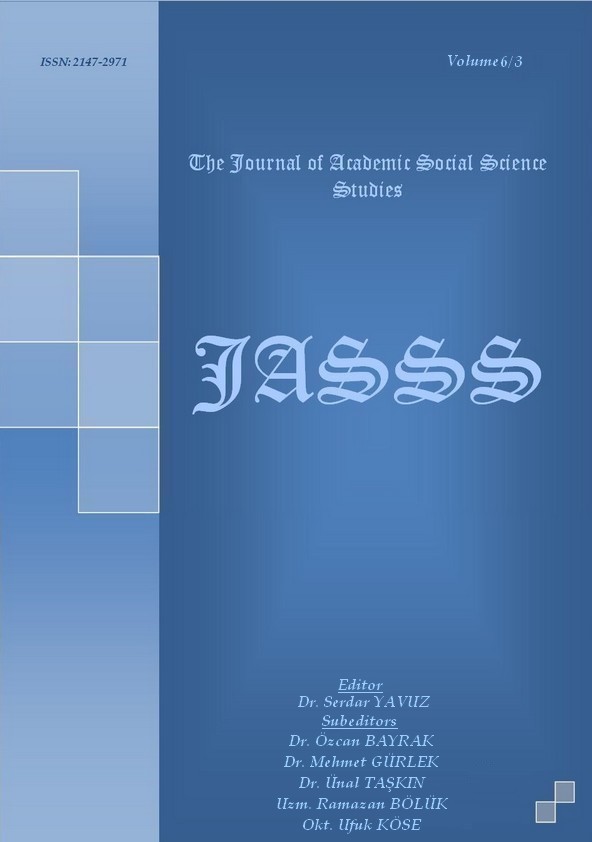NÂBÎ DÎVÂNINDA GEÇEN ARAP KÖKENLİ SÖZLERİN TELAFFUZU İLE GÜNÜMÜZ TÜRKİYE TÜRKÇESİNDEKİ TELAFFUZLARININ KARŞILAŞTIRILMASI
Author :
Abstract
Dünyanın değişik coğrafyalarındaki konuşulan birçok dili incelediğimizde başka dillerden binlerce kelime aldığına şahit olmaktayız. Türkçeden başka dillere kelime geçtiği gibi Türkçeye de birçok farklı dilden kelime gelmiştir. Bunlardan en önemlisi Arapçadır. Bir dil esas yapısını koruyabilmesi için başka dillerden almış olduğu kelimeleri kendi ses ve gramer yapısına uygunlaştırması gerekmektedir. Türklerin Araplarla tanışmaları ve İslâmiyeti kabul etmeleriyle birlikte Arapçadan Türkçeye kelimeler girmeye başlamıştır. Tabi Türkçenin ses yapısı ile Arapçanın ses yapısı farklı olduğundan alınan kelimeler zamanla Türkçeye uygunlaştırılmıştır. XVII. yüzyıl Dîvân Edebiyatı şairlerinden Nâbî’nin Dîvânında geçen yabancı kelimelerden yarıdan fazlası Arap kökenli kelimelerdir. Nâbî Dîvânında geçen ve günümüz Türkiye Türkçesinde kullanılan birçok kelimede ses değişikliği olmamıştır. Nâbî’nin yaşadığı 17. yüzyılda kullanılan alfabe Arap alfabesi olduğu için Arap kökenli kelimelerdeki uzun sesleri göstermede uzatma harfleri olan elif ( ? ), ye ( ? ) ve vav ( ? ) harfleri kullanılmaktaydı. Meselâ; (????) kelimesinde “a” seslisi uzun okunmalıdır. Latin alfabesinde bu sesi verecek bir işaret bulunmadığından düzeltme (uzatma, inceltme) işareti adında a, ı ve u seslerinin üzerine ( ^ ) konularak ( â, î, û ) seslileri oluşturulmuştur. Ayrıca Arap alfabesindeki kaf ( ? ) ve kef ( ? seslerinin karşılığı olarak Türkiye Türkçesinde “k” sesi kullanılmaktadır. Arapça “kalem” kelimesi “kaf” ile (??? ) “kâmil” kelimesi “kef” ile ( ????) yazılmaktadır. Bu ses farkını belirtmek için Türkiye Türkçesinde “a” ve “â” seslileri kullanılır. O dönemde Arap alfabesi kullanıldığından yazıdan hareket ederek günümüzdeki söyleniş biçimlerine göre mevcut değişiklikleri örneklerle göstermeye çalıştık.
Keywords
Abstract
When we analyze languages which are spoken in different parts of the world, we realize that they have received thousands of words from other languages. Since some words got transferred to other languages from Turkish, Turkish received some from them as well. Arabic is the most important among those languages. As soon as Turks got acquinted with Arabs and accepted Islam as their official religion, the introduction of some Arabic words to Turkish was set to start. As a matter of course, due to the differences in phonetic systems between Turkish and Arabic, the borrowed words got optimized in time. Nabi was one of the 17th century Divan Literature poets. More than half of the used words in Nabi’s Divan were of Arabic origin. Many of the words which were seen in Nabi’s Divan and are used in Turkish today didn’t have phonetic changes. The alphabet of Turkish in Nabi’s period was Arabic alphabet. Therefore, some signs (such as elif (?), ye (?) and vav (?)) were used in order to demonstrate the long vowel sounds in Arabic origin words. For instance, the sound /a/ in the word (????) must be pronounced longer. Because there was no sign that could produce this sound, the correction symbol (^) was used over letters a, ı, and u (â, î, û) to demonstrate the significance of the se sounds. Likewise, in Turkish, letter “k” is used to demonstrate the equivalent of Arabic letters kaf (?) and kef (?). The word “pen” (kalem) is written with the letter kaf (?) (???) in Arabic, and the word “perfect” (kâmil) is written with the letter “kef” (?) (????). In Turkish “a” and “â” vowels are used in order to demonstrate this phonetic difference. Taking into consideration the fact that Arabic alphabet was in use during the mentioned time, we tried to demonstrate the alterations based on some examples with respect to their present pronunciation.
